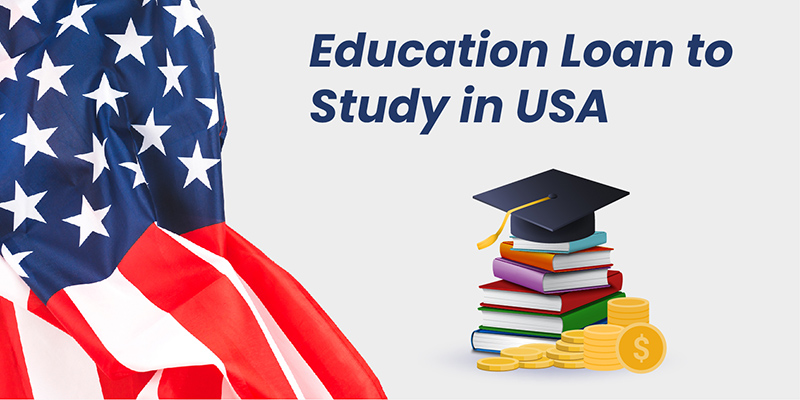How to Get the Student Loan in United States

Discover the essential information you need to finance your education
How to Get the Student Loan in United States
In today's world, higher education often comes with a hefty price tag. For international students, especially those from India, pursuing their dreams of studying in the United States can be financially challenging. However, fret not! This comprehensive guide will walk you through the intricate process of securing a student loan in the United States, specifically tailored for Indian students.
Understanding the Application Process for Education Loan in USA
Before you embark on your educational journey in the United States, it's crucial to grasp the application process for an education loan.
Gather Essential Documents
Start by gathering essential documents, including proof of admission, visa documents, financial statements, and identification.
Choose the Right Lender
Research and select a suitable student loan provider with favorable terms and interest rates.
Complete the Application
Fill out the loan application accurately, ensuring all details are correct.
Wait for Approval
After submission, patiently wait for your loan application to be approved.
Student Loan Provider List in United States
When it comes to financing your education in the United States, choosing the right student loan provider is a crucial decision. Here are some well-known student loan providers that offer a variety of loan options to meet your educational needs:
1. Sallie Mae
- Sallie Mae is one of the largest and most recognized student loan providers in the United States.
- They offer a wide range of student loan products, including undergraduate, graduate, and parent loans.
- Sallie Mae provides options for both federal and private student loans.
2. Wells Fargo
- Wells Fargo offers private student loans with competitive interest rates and flexible repayment options.
- They provide loans for undergraduate, graduate, and professional degree programs.
- Borrowers can benefit from additional features like interest rate discounts for autopay.
3. Discover Student Loans
- Discover is a well-established financial institution that offers private student loans to undergraduate and graduate students.
- They provide fixed and variable interest rate options and rewards for good grades.
- Discover also offers loan consolidation services.
4. Citizens Bank
- Citizens Bank offers private student loans for undergraduates and graduates.
- They provide various repayment options, including deferred, interest-only, and immediate repayment plans.
- Borrowers may be eligible for multi-year approval, simplifying the loan application process.
5. SoFi (Social Finance)
- SoFi is known for its student loan refinancing options, making it a suitable choice for those looking to consolidate existing loans.
- They offer competitive rates and unique features like career counseling and networking events.
- SoFi also provides undergraduate and graduate student loans.
These are just a few of the reputable student loan providers available in the United States. When considering a student loan, it's essential to compare interest rates, repayment terms, and any additional benefits or incentives offered by each lender. Additionally, be sure to understand the difference between federal and private student loans and choose the option that best suits your financial situation and educational goals.
Exploring the Different Types of Student Loans
When it comes to funding your education in the United States, you'll encounter various types of student loans. Understanding the differences between these loans is essential, as it can significantly impact your financial future. Here are the primary types of student loans:
1. Federal Student Loans
Federal student loans are provided by the U.S. Department of Education. They are typically the first choice for students due to their borrower-friendly terms and benefits. There are several types of federal student loans:
a. Direct Subsidized Loans
- These loans are available to undergraduate students with financial need.
- Interest does not accrue while you're in school, during the grace period, or in deferment.
b. Direct Unsubsidized Loans
- Undergraduate, graduate, and professional degree students can qualify for these loans.
- Interest accrues from the time the loan is disbursed, even while you're in school.
c. Direct PLUS Loans
- These loans are available to parents of dependent undergraduate students and graduate or professional degree students.
- Credit checks are required, and interest begins accruing immediately.
d. Perkins Loans
- Perkins Loans are need-based loans for undergraduate and graduate students with exceptional financial need.
- They offer a low fixed interest rate.
2. Private Student Loans
Private student loans are offered by banks, credit unions, and other financial institutions. They are an option when federal loans don't cover all your educational expenses. Key points to consider:
a. Interest Rates
- Private loans may have fixed or variable interest rates, often based on your creditworthiness.
b. Credit Requirements
- Private lenders typically require a credit check, and having a good credit score can lead to more favorable terms.
c. Cosigners
- Many students, especially those with limited credit history, may need a cosigner to qualify for private loans.
3. Institutional Loans
Some colleges and universities offer their own loan programs to help students cover tuition and other expenses. These loans often have unique terms and may be based on financial need or academic performance.
4. State-Based Loans
Many states have their own student loan programs, which can offer competitive interest rates and favorable terms to residents attending in-state institutions.
5. Refinancing and Consolidation Loans
After graduation, you can explore loan refinancing and consolidation options to simplify your repayment. These loans allow you to combine multiple loans into one and potentially secure a lower interest rate.
When considering student loans, it's crucial to exhaust all federal loan options before turning to private loans, as federal loans typically offer more flexible repayment plans, loan forgiveness options, and lower interest rates. Always review the terms and conditions of any loan you're considering, and make informed decisions based on your financial situation and long-term goals.
Tips for a Successful Loan Application in the United States
Securing a student loan is a significant step towards financing your education in the United States. To increase your chances of a successful loan application, consider the following tips:
1. Maintain Good Credit
A strong credit history can greatly impact your eligibility for loans and the interest rates you'll be offered. Pay your bills on time, reduce outstanding debts, and manage credit responsibly to maintain good credit.
2. Apply Early
Start the loan application process well in advance. Some loans have limited funds, and applying early ensures you have access to a wider range of options. Early applicants often receive more favorable terms.
3. Explore Scholarships and Grants
Before resorting to loans, research and apply for scholarships and grants. These forms of financial aid don't require repayment and can significantly reduce your educational expenses.
4. Consider a Co-signer
If you have limited credit history or income, a co-signer with good credit can enhance your eligibility and help secure a lower interest rate. Ensure your co-signer understands the responsibilities involved.
5. Understand Loan Terms
Thoroughly review the terms and conditions of the loan, including interest rates, repayment schedules, and any associated fees. Understand the total cost of borrowing over the life of the loan.
6. Complete the FAFSA
If you're applying for federal aid, such as Direct Subsidized or Unsubsidized Loans, start by completing the Free Application for Federal Student Aid (FAFSA). This form helps determine your eligibility for various federal programs.
7. Provide Accurate Information
Ensure that all information on your loan application is accurate and up-to-date. Inaccuracies or inconsistencies may result in delays or denials.
8. Seek Financial Aid Counseling
Consult your school's financial aid office for guidance. They can help you understand your options, assist with the application process, and provide information on scholarships and grants specific to your institution.
9. Maintain Enrollment Status
To remain eligible for most loans, you must maintain either full-time or half-time enrollment. Dropping below these thresholds can affect your loan disbursements and repayment status.
Eligibility Criteria for Student Loans in the United States
Securing a student loan in the United States requires meeting specific eligibility criteria. These criteria may vary depending on the type of loan you're applying for, but here are some common eligibility requirements to consider:
1. Enrollment in an Accredited Institution
To be eligible for most student loans, you must be enrolled in an accredited educational institution. Accreditation ensures that the school meets certain educational standards, making it a legitimate recipient of federal and private funding.
2. Valid Visa Status
For international students, including those from India, it's crucial to maintain a valid visa status throughout your academic program. Student loans are typically available to individuals with F-1 or J-1 visas. Make sure to adhere to the visa regulations to remain eligible for financial aid.
3. Financial Stability
Lenders and institutions offering student loans will assess your financial stability. This includes evaluating your credit history and financial resources. Having a good credit score and a co-signer with a strong credit history can improve your eligibility and help you secure more favorable loan terms.
4. Satisfactory Academic Progress
Many loans, especially federal ones, require you to maintain satisfactory academic progress (SAP). SAP is determined by your institution and usually involves meeting minimum GPA requirements and completing a certain number of credits each semester. Falling below these standards could affect your loan eligibility.
5. Citizenship or Eligible Non-Citizen Status
U.S. citizens, permanent residents (Green Card holders), and eligible non-citizens can qualify for federal student loans. Eligible non-citizens typically include refugees, asylees, and individuals with specific visas (such as T or U visas). Verify your status to determine your eligibility.
6. Not in Default on Previous Student Loans
If you have existing student loans, it's essential to ensure you're not in default on any of them. Defaulting on a loan can lead to ineligibility for future financial aid and may result in legal consequences.
7. Compliance with Selective Service Registration
Male applicants between the ages of 18 and 25 must register with the Selective Service System. Failure to register can affect eligibility for federal student aid, including loans.
How to Repay Your Student Loan
Repaying your student loan is an important financial responsibility that follows your educational journey. To ensure a smooth repayment process, follow these steps:
Understand Your Loan Terms
Before you start repaying your student loan, it's crucial to fully understand the terms and conditions of your loan. This includes knowing the interest rate, the repayment schedule, and any available grace periods. You can find this information in your loan agreement.
Create a Budget
Develop a budget that includes your monthly loan payments. Consider your other financial obligations, such as rent, utilities, groceries, and transportation. Creating a comprehensive budget will help you allocate funds for loan repayment without compromising your daily needs.
Explore Repayment Plans
Federal student loans typically offer several repayment plans to choose from:
3.1. Standard Repayment Plan
- Fixed monthly payments over a 10-year period.
- Higher monthly payments but lower overall interest costs.
3.2. Income-Driven Repayment Plans
- Monthly payments based on your income and family size.
- Options include Income-Based Repayment (IBR), Pay As You Earn (PAYE), and Revised Pay As You Earn (REPAYE).
- Ideal for borrowers with fluctuating incomes.
3.3. Graduated Repayment Plan
- Payments start low and increase every two years.
- Suitable for borrowers expecting their income to rise gradually.
3.4. Extended Repayment Plan
- Extends the repayment term up to 25 years.
- Reduces monthly payments but increases the total interest paid.
Make Timely Payments
Consistently making on-time payments is essential to avoid late fees and negative impacts on your credit score. Set up automatic payments or reminders to ensure you never miss a due date.
Consider Loan Forgiveness Options
If you work in a public service job or for a nonprofit organization, you may be eligible for loan forgiveness programs, such as Public Service Loan Forgiveness (PSLF). These programs forgive your remaining loan balance after a certain number of qualifying payments.
Extra Payments and Loan Consolidation
If you have extra funds available, consider making additional payments towards your principal balance. This will help you pay off your loan faster and reduce the total interest paid. Additionally, loan consolidation can be an option to combine multiple loans into one, simplifying your repayment process.
Communicate with Your Loan Servicer
If you encounter financial difficulties or anticipate problems with repayment, don't hesitate to contact your loan servicer. They can provide guidance and potentially offer temporary relief through deferment, forbearance, or alternative repayment plans.
Stay Informed
Keep yourself informed about any updates or changes in your loan terms. Review your loan statements regularly, and notify your loan servicer of any changes in contact information or financial status.
Pay Extra When Possible
Whenever you receive extra income, such as a tax refund or a work bonus, consider putting a portion of it towards your student loan. These additional payments can significantly reduce your loan balance and save you money on interest.
By following these steps and staying committed to responsible financial management, you can successfully repay your student loan and achieve financial freedom. Remember that timely payments and responsible budgeting are key to a debt-free future.
You are now well-equipped to navigate the process of obtaining a student loan in the United States as an Indian student. Remember, education is an investment in your future, and with the right financial support, your dreams of studying in the U.S. can become a reality.
FAQs
1. Is it challenging for Indian students to secure loans in the United States?
Securing a student loan can be competitive, but with proper planning and research, Indian students can find suitable options.
2. What are the advantages of federal student loans over private loans?
Federal loans often offer lower interest rates and more flexible repayment options compared to private loans.
3. Can I work part-time while studying in the United States to help with loan repayment?
Yes, many international students work part-time jobs to cover living expenses and contribute to loan repayment.
4. Is it possible to refinance student loans in the United States?
Yes, refinancing options are available to help lower interest rates and simplify repayment.
5. How long does it typically take to repay a student loan in the United States?
The repayment period varies but is usually between 10 to 25 years, depending on the loan type and terms.
- Share This Job



Write A Comment
No Comments